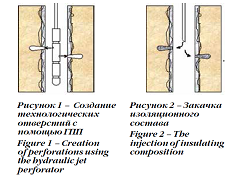- Home page /
- Technologies /
- Our publications about technologies /
- Effective Technology for Behind-The-Casing Flows Elimination...
Effective Technology for Behind-The-Casing Flows Elimination in Oil and Gas Wells
 The bottomhole zone of a well is a place where a number of contradictive physicalchemical phenomena occur. Among such phenomena one can find underbalance – a flow of formation fluid into a wellbore, as well as overbalance – a flow of wellbore fluid back into formation.
The bottomhole zone of a well is a place where a number of contradictive physicalchemical phenomena occur. Among such phenomena one can find underbalance – a flow of formation fluid into a wellbore, as well as overbalance – a flow of wellbore fluid back into formation.
Depending on the oil/gas ratio of the flow, the formation fluid temperature can change dramatically in comparison with the original formation temperature due to the Joule- Thompson effect (throttling). A variety of other phenomena may take place in a well. Many of them can affect the production capacity of the well and even of the whole field. Oil and gas recovery process may be accompanied by different physical-chemical phenomena that can decrease the oil/gas recovery factor down to only 2–3% (according to present-day measures).
In that case, the formation will contain a large volume of hydrocarbons holding immobile.
The original opinion of different specialists about the reasons of behind-the-casing flows occurrence was the following. Such flows were considered to be due to the damage of cement sheath that surrounds the casing string.
However, a large number of cases when wells had pressure-tight cement sheath around the casing string and still had a devastating water influx, made the specialists to change their minds.
On the basis of geophysical surveys the specialists proved that the main zone of water influx was situated near the perforation interval.
In particular, this fact was proved by NGDU Ahtyrka neftegas working at Eugenjenskoe gas condensate field. In order to perform water shutoff operation at one of the wells, the crew had to completely isolate the old perforation interval and make a new one below. This allowed to fully restore the well flow rate.
.....
Full version of the article can be downloaded here.
-
24.12.2021
Gazprom Neft, Skoltech and the Khanty-Mansi autonomous okrug-Yugra are developing technologies to produce hard-to-recover oil
-
17.12.2021
Gazprom neft establishes Russia’s first test facilities for developing hard-to-recover oil production technologies
-
25.11.2021
LUKOIL successfully tries out casing drilling
-
08.11.2021
Gazprom Neft and Gazprom Burenie to support the development of Russia’s first oil- and gas-well drilling robot

